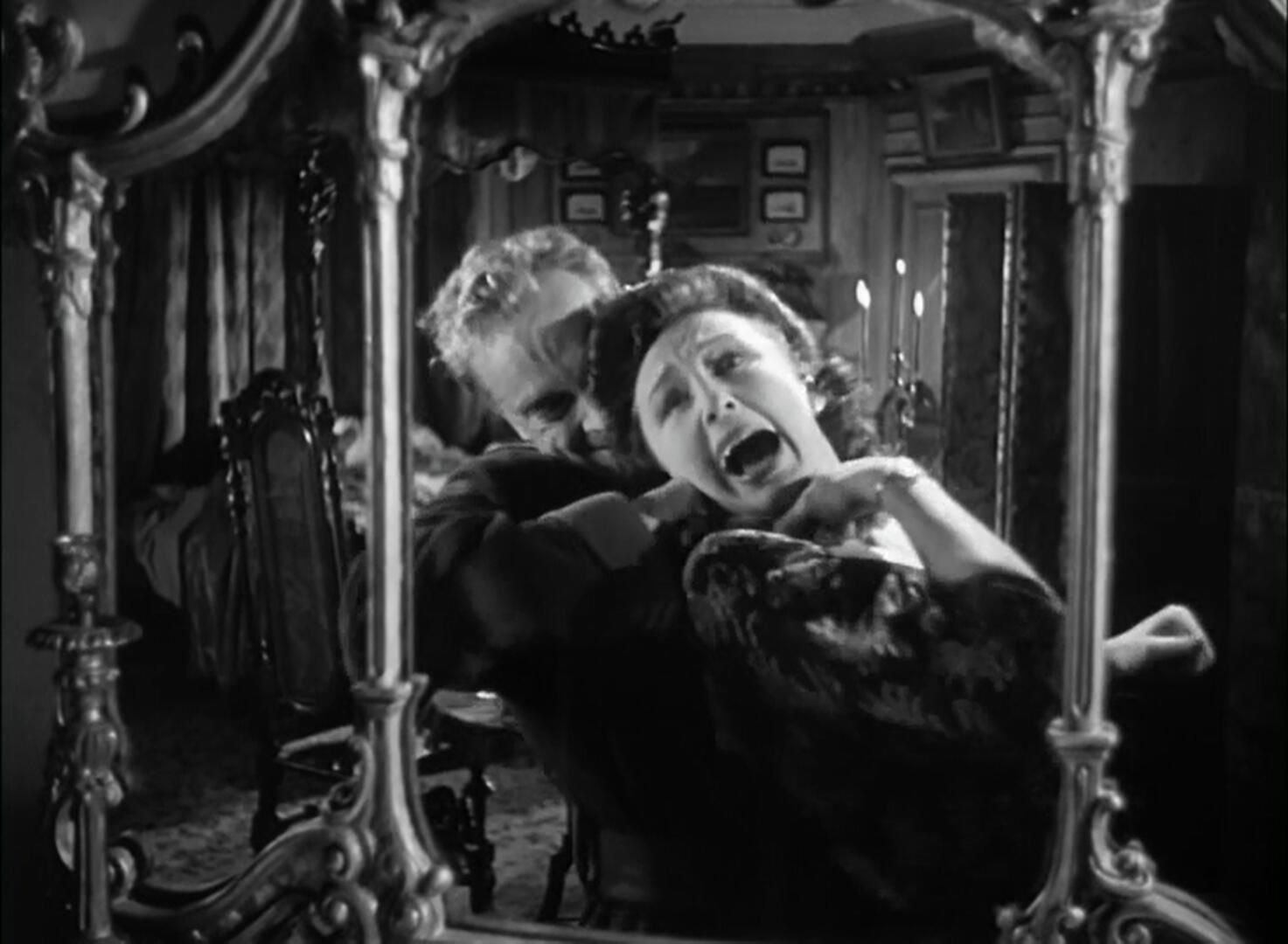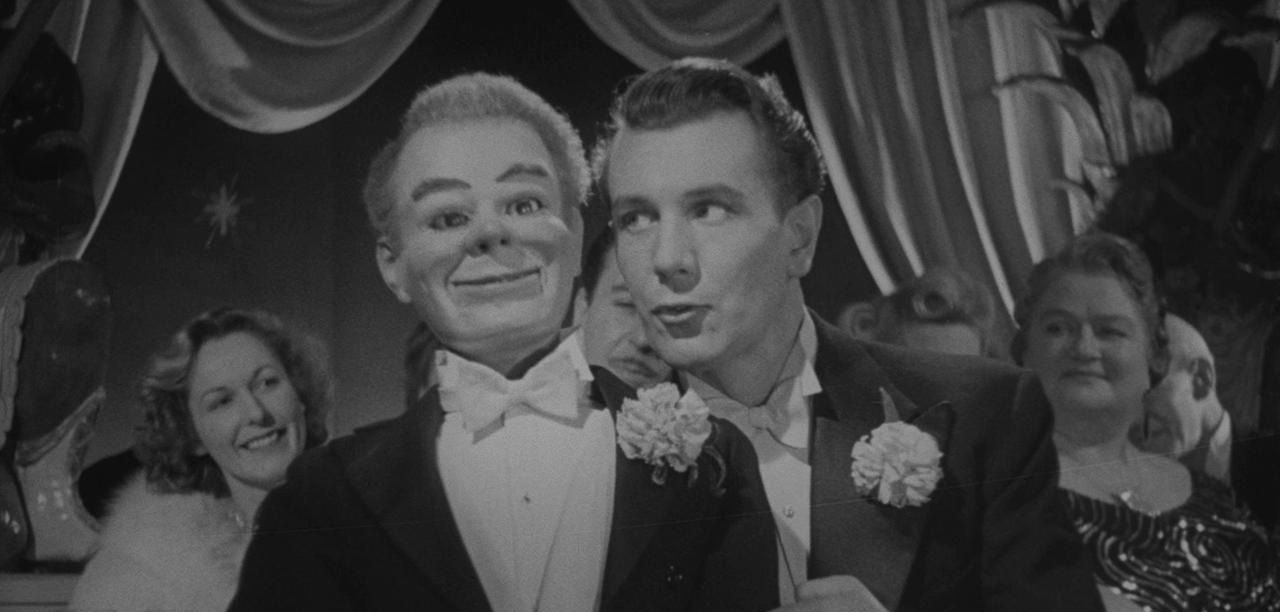People sitting around, telling each other stories doesn’t necessarily seem all that cinematic. But in the hands of the right filmmaker, the right actors, the right studio, it can be magical. Or chilling, as is the case with 1945’s Dead of Night, a movie from plummy British film staple Ealing Studios. Known for dramas and comedies throughout the ’30s and ’40s, Ealing made its mark on the horror genre with the anthology film, utilizing the kind of ghost story only the English could produce. Dead of Night, despite its age, is still supremely effective, and influenced generations of portmanteau films to come.
There’s a tone throughout Dead of Night that puts the viewer ill at ease. Despite a lot of pleasant and even drolly humorous dialogue (so very British, and so very ’40s), the direction puts one off-balance from beginning to end. The film—which consists of five stories and an equally compelling wraparound narrative—has four directors, and it’s a wonder the movie doesn’t feel as disjointed as it might. Alberto Cavalcanti directs the second and fifth story; Basil Dearden directs the first story and the framing sequences; and future Ealing Comedies stalwarts Robert Hamer and Charles Crichton direct the third and fourth stories, respectively.

And what are these stories? A horror anthology is nothing without compelling and creepy stories. Well, the creepiness seeps in right from the start. The framing story finds a man named Walter Craig (Mervyn Johns) driving to his friend Eliot Foley’s (Roland Culver) country cottage to spend a relaxing weekend. He’s had a spate of bad dreams and feels he could use the rest. However, upon arrival, Craig gets the strangest feeling of déjà vu. He tells his friend and the man’s assembled guests that he knows them all; they’ve all appeared in his dreams. Craig feels very out of sorts. Luckily, one of the guests is a respectable psychologist, Dr. Van Straaten (Frederick Valk), who tries to convince Craig that his fears of what else might come true are unfounded.
From there, we launch into a series stories from the assembled guests. Each of them, it seems, has had some interaction with the supernatural or uncanny. Race car driver Hugh Grainger (Antony Baird) tells a story about how, after an accident, he had dreams of a hearse-driver appearing and telling him there’s “just room for one inside, sir,” only for an ill-fated bus driver to say the same thing; the young Sally O’Hara (Sally Ann Howes) shares that during a Christmas party at an orphanage, she encountered the ghost of a young boy.

Later, once Sally goes to bed, the affluent Joan Cortland (Googie Withers) tells the terrible tale of her husband’s obsession with an antique mirror owned by a murderous hedonist; Eliot tells a humorous yarn about two golfing buddies (Basil Radford and Naunton Wayne) who fight over a girl, even after one of them dies; and finally, Dr. Van Straaten himself relays a case history of his, wherein an unbalanced ventriloquist (Michael Redgrave) believed his dummy was truly alive.
None of these stories do much to assuage Mr. Craig, especially when other moments from his dream begin to happen.

There’s a literary quality to the whole film; “The Hearse Driver” comes directly from a ghost story written by E.F. Benson in 1906. Though Benson is only credited with this one vignette, his other story “The Room in the Tower” appears to at least notionally have been the basis for screenwriters Angus MacPhail and John Baines’ framing story. They both involve a man plagued with recurring nightmares of a location he’s never been, only to end up going to that location and having the dream come true. Benson’s breed of ghost story—chummy, humorous, but deadly—is exactly the timbre of the wraparound segments. “The Golfer’s Story” is based on “The Story of the Inexperienced Ghost” by H.G. Wells but certainly feels more at home with bawdier comedy of the era.

There’d been anthology movies before Dead of Night, and even a couple of silent horror anthologies. But Dead of Night brought the format to the mainstream. It was a massive hit. And it did so by lulling its audience in a series of increasingly scary vignettes. “The Hearse Driver” is moderately spooky; “The Christmas Party” is effectively chilly; then we move on to some grown-up scares. “The Haunted Mirror” has a lot to say about seemingly idyllic relationships, and how beneath a prim and proper man can lurk a debauched and murderous side waiting to get out. “The Golfer’s Story” is a broad farce, taking the audience out of the scares and into the realm of light fantasy.

But that comedic longueur is just a diversion before the film’s most chilling segment. “The Ventriloquist’s Dummy” is the birth of the modern “dummies are scary as hell” subgenre. Michael Redgrave plays the troubled ventriloquist who begins to believe his dummy, Hugo, is alive and malevolent. Neither actuality is very reassuring; either the man has split personalities with his domineering dummy character, or, even more upsetting, the dummy is alive. Alive and murderous, yet.
A precursor to things like Psycho or Magic, this segment is the most viscerally terrifying. Redgrave gives a wide-eyed and manic performance as a man at the end of his tether. And Hugo is really upsetting, his squinty-eyed grin and tiny voice belie true villainy, whether he’s alive or not. There’s a reason this segment is famous: it’s iconic.

Dead of Night ends with a swirling fever dream wherein Mr. Craig hallucinates (maybe) going through all of the stories he’s just heard. The camera swings wildly and the editing is suddenly frenetic; it’s a shocking ending to a movie that has done its best to make you feel somewhat safe. It’s anything but.
While relatively unknown in the U.S. after its initial release, Dead of Night became a staple in Britain. It inspired American expat producer Milton Subotsky of Hammer rival Amicus Pictures to launch a series of portmanteau horror films with framing narration, including the original Tales from the Crypt in 1972. Any movie of this nature—from Ghost Stories to V/H/S to ABCs of Death—owes a debt to Dead of Night.

If you haven’t seen this film, it’s out now on Blu-ray from Kino Lorber with a thoroughly researched audio commentary by the great author and critic Tim Lucas. Despite its age, Dead of Night still packs a wallop and sends the shivers right up your back, even almost three-quarters of a century later.
Images: Ealing/Kino Lorber
Kyle Anderson is the Editor at Large for Nerdist. You can find his film and TV reviews here. Follow him on Twitter!

